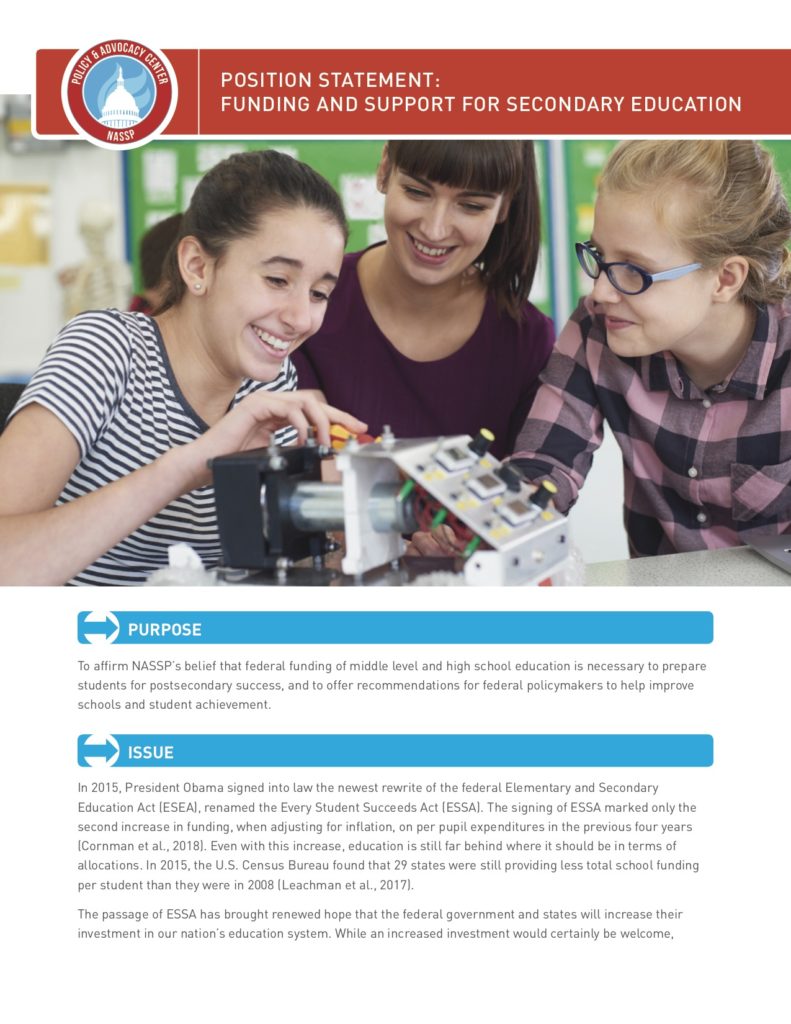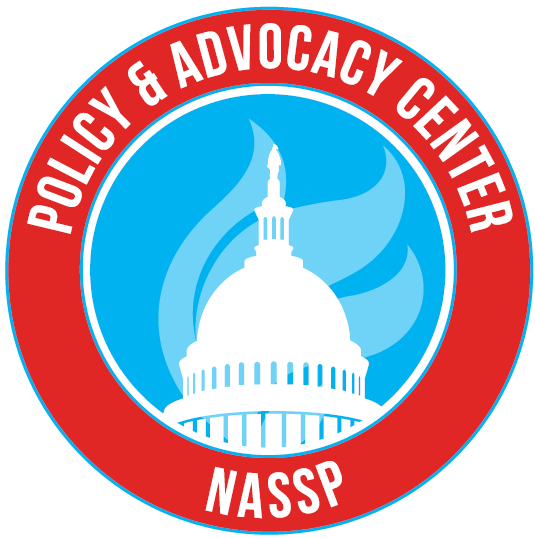To affirm NASSP’s belief that federal funding of middle level and high school education is necessary to prepare students for postsecondary success, and to offer recommendations for federal policymakers to help improve schools and student achievement.
In 2015, President Obama signed into law the newest rewrite of the federal Elementary and Secondary Education Act (ESEA), renamed the Every Student Succeeds Act (ESSA). The signing of ESSA marked only the second increase in funding, when adjusting for inflation, on per pupil expenditures in the previous four years (Cornman et al., 2018). Even with this increase, education is still far behind where it should be in terms of allocations. In 2015, the U.S. Census Bureau found that 29 states were still providing less total school funding per student than they were in 2008 (Leachman et al., 2017).
The passage of ESSA has brought renewed hope that the federal government and states will increase their investment in our nation’s education system. While an increased investment would certainly be welcome, it may also be a valid starting point for addressing another issue that has plagued federal education funding for far too long. Over the years, efforts at the state and federal levels have been placed on providing adequate funding for preschool and elementary education programs. Notably, the federal ESEA placed much more emphasis on elementary than secondary schools and effectively left the “S” out of “ESEA,” and this continues with ESSA. Such emphasis is primarily attributable to the belief that addressing educational needs early in a student’s life presents the best opportunity of success in school. Although NASSP accepts this premise, more resources need to be focused on middle level and high schools.
As evidence of this need, a 2015 report by the National Center for Education Statistics found that grades 6–12 received only 38 percent of Title I funds in school year 2009–10 from ESEA, which provided the primary source of federal support for K–12 schools.
Middle level and high school students deserve to have access to the same high-quality education that they receive in the early grades, and the failure to meet students’ needs in the latter years of their educational experience often translates into lower performance and higher drop-out rates. In addition, it lessens the likelihood that students will transition to higher education or successful careers.
Guiding Principles
- Federal, state, and local secondary school programs that are fully funded help all students graduate with the knowledge and skills needed for post-graduation success.
- Well-educated citizens contribute significantly to a robust economy, national security, and a host of additional positive societal characteristics. It is essential and appropriate that federal resources be provided throughout the education continuum to ensure that all students become productive citizens.
- Congress and state legislatures routinely approve laws that necessitate local compliance. To be effectively implemented, many of these statutes require adequate funding. The federal and state governments must provide appropriate resources to meet these mandates.
- Public schools provide education to 90 percent of American citizens; therefore, state and federal funding for education must be targeted to public schools, especially those with the greatest need.
Recommendations
Recommendations for Policymakers
- Initiate and fund federal, state, and local legislative initiatives that specifically address the educational needs of secondary school students.
- Refrain from initiating state and federal initiatives that divert funding from public secondary schools to private sources.Create a separate funding stream to improve student achievement at the middle and high school levels and turn around low-performing secondary schools.
- Fully fund all programs in ESSA and IDEA at their authorized levels.
- Authorize resources for a comprehensive literacy policy containing four distinct elements—early childhood, grades K–3, middle grades, and high school.
- Allocate at least five cents of every dollar in the federal budget to education in order to reflect a level of commitment commensurate with other important national priorities and to meet the educational needs of all students effectively.
Recommendations for District Leaders
- Allocate funds in accordance with the proportion of elementary, middle level, and high schools contained within your jurisdiction.
- Advocate with state and federal representatives for the proper allocation of funds for secondary education programs and initiatives.
Recommendations for School Leaders
- Collect and share with elected representatives information on state and federal programs in a school to display the effectiveness and importance of proper funding allocations.
Resources
Committee for Education Funding (2018). Education Matters: Investing in America’s Future. Retrieved from https://cef.org/charts-and-resources/charts/.
Cornman, S.Q., Zhou, L., Howell, M.R., and Young, J. (2017). Revenues and Expenditures for Public Elementary and Secondary Education: School Year 2014–15 (Fiscal Year 2015). U.S. Department of Education. Washington, D.C.: National Center for Education Statistics. Retrieved from http://nces.ed.gov/pubsearch.
Leachman, M., Masterson, K., & Figueroa, E. (2018). A Punishing Decade for School Funding. Retrieved from www.cbpp.org/research/state-budget-and-tax/a-punishing-decade-for-school-funding.
National Coalition for Public Education (2017). Facts About Vouchers. Retrieved from www.ncpecoalition.org/facts – Public-Schools.
Niebling, R. & Lovell, P. (2015). Never Too Late. Retrieved from http://all4ed.org/wp-content/uploads/2015/05/NeverTooLate.pdf.
United States Census Bureau (2016). Public Education Finances: 2014. Retrieved from www.census.gov/content/dam/Census/library/publications/2016/econ/g14-aspef.pdf.
United States Department of Education (2015). Improving Basic Programs Operated by Local Education Agencies (Title I, Part A). Retrieved from www2.ed.gov/programs/titleiparta/index.html.


